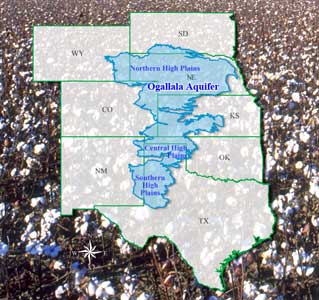Issue 3 Table of Contents

|
FEATURED ARTICLEAgronomy and Soils Heat Unit Availability for Cotton Production in the Ogallala Aquifer Region of the United States A. M. Esparza, P. H. Gowda, R.L. Baumhardt, T. Marek, and T. A. Howell
Pages: 110-117
Abstract
| Full Text PDF (659K)
The Ogallala Aquifer is facing declining water levels. One option to reduce groundwater withdrawal for irrigation is the adoption of lower water use crops, such as cotton; however, temperature can be a limiting factor for cotton production in the Central and Northern High Plains of the aquifer. Based on heat unit availability, cotton is a viable alternative crop for all counties of the Texas and Oklahoma panhandles and for most of the counties of southwestern Kansas.
|
|---|
Issue Editors
|
Agronomy and Soils
Heat Unit Availability for Cotton Production in the Ogallala Aquifer Region of the United States A. M. Esparza, P. H. Gowda, R.L. Baumhardt, T. Marek, and T. A. Howell
Pages: 110-117 Abstract
| Full Text PDF (659K)
Breeding and Genetics
Evaluation of an Exotic Germplasm Population Derived from Multiple Crosses among Gossypium Tetraploid Species Linghe Zeng, William R. Meredith, Deborah L. Boykin, and Earl Taliercio
Pages: 118-127 Abstract
| Full Text PDF (227K)
Engineering and Ginning
Survey of Seed-cotton and Lint Cleaning Equipment in U.S. Roller Gins D.P. Whitelock, C.B. Armijo, G.R. Gamble, and S.E. Hughs
Pages: 128-140 Abstract
| Full Text PDF (1276K)
Textile Technology
Cotton Textile Processing: Waste Generation and Effluent Treatment B. Ramesh Babu, A.K. Parande, S. Raghu, and T. Prem Kumar
Pages: 141-153 Abstract
| Full Text PDF (304K)
|
Textile Technology
Using the Reactive Dye Method to Covalently Attach Antibacterial Compounds to Cotton D. T. W. Chun, and G.R. Gamble
Pages: 154-158 Abstract
| Full Text PDF (164K)
Textile Technology
Pilot Study to Examine the Relationship between AFIS Fiber Properties and White Speck Occurrence P.Z. Altintas, J. L Simonton, and M. G. Beruvides
Pages: 159-167 Abstract
| Full Text PDF (391K)
Weed Science
Flue-cured Tobacco and Peanut Response to Diuron, Fluometuron, and Prometryn Applied to a Preceding Cotton Crop Loren R. Fisher, Alan. C. York, and David L. Jordan
Pages: 168-176 Abstract
| Full Text PDF (219K)
|
